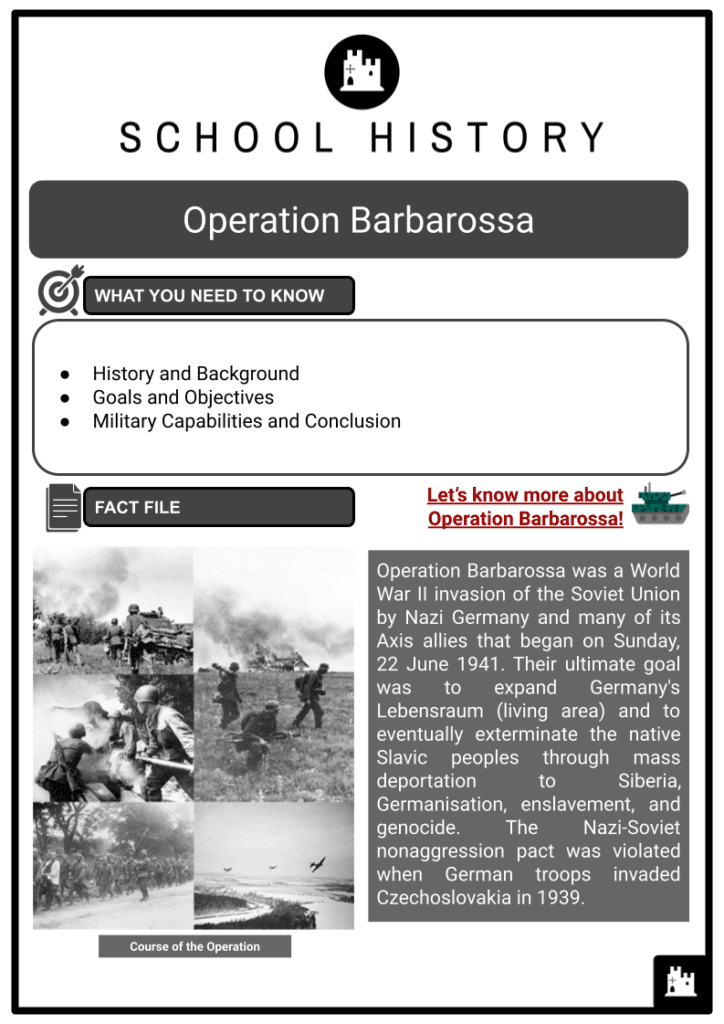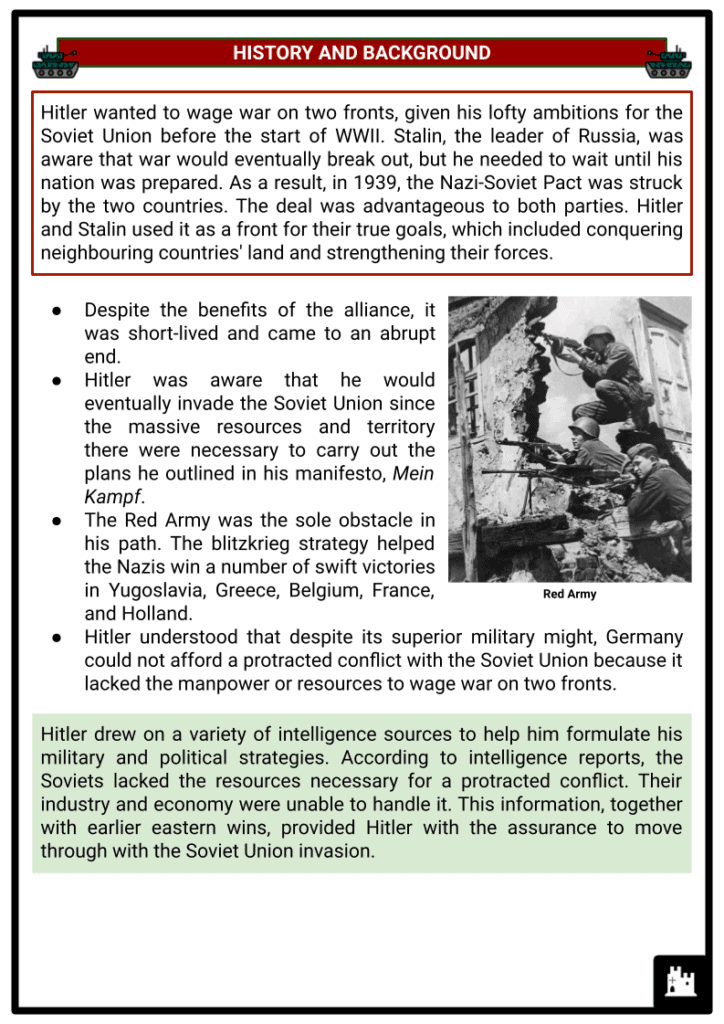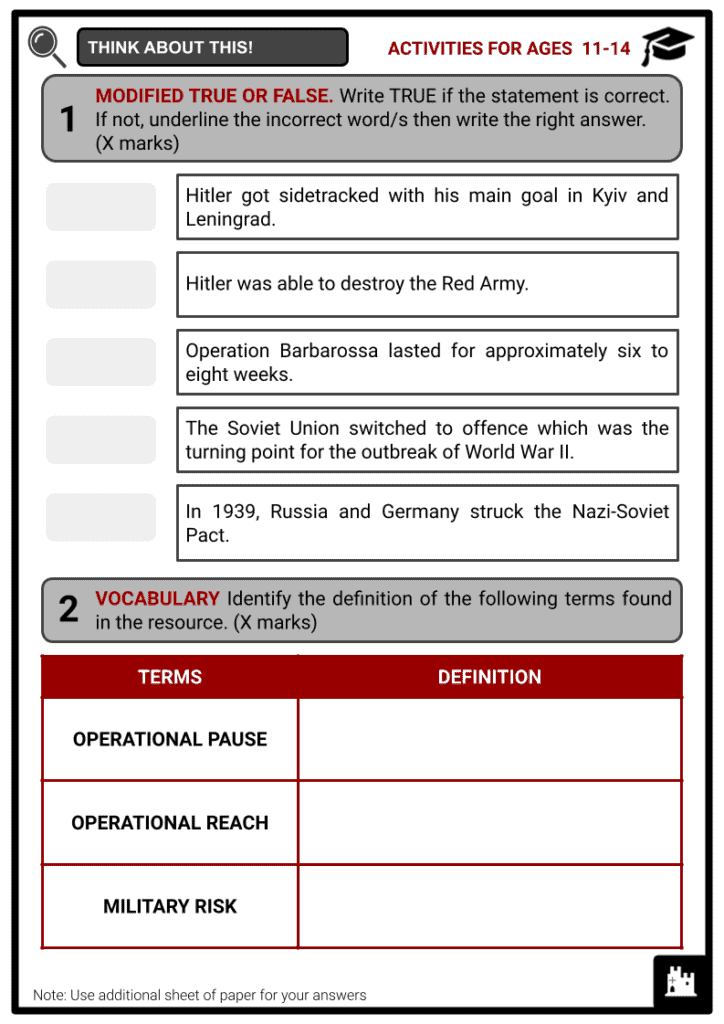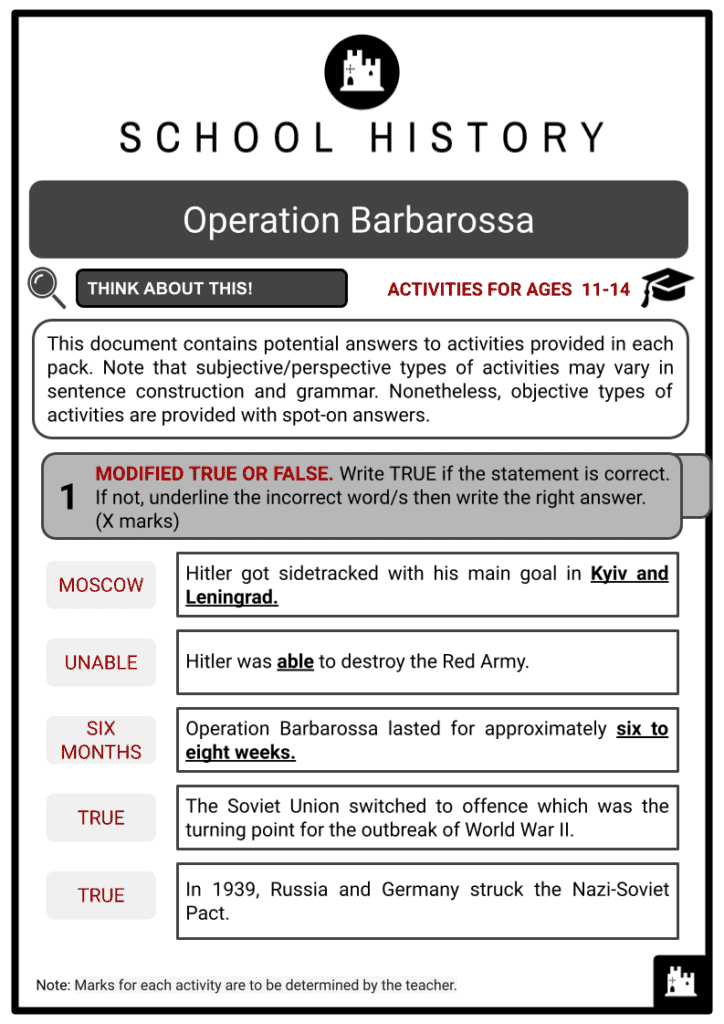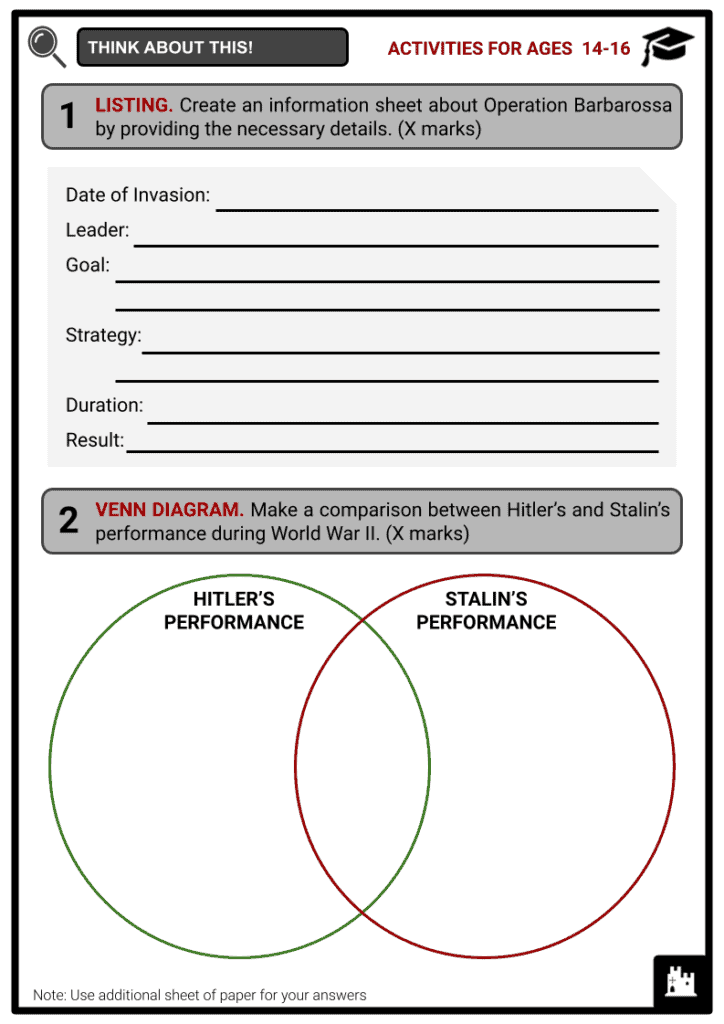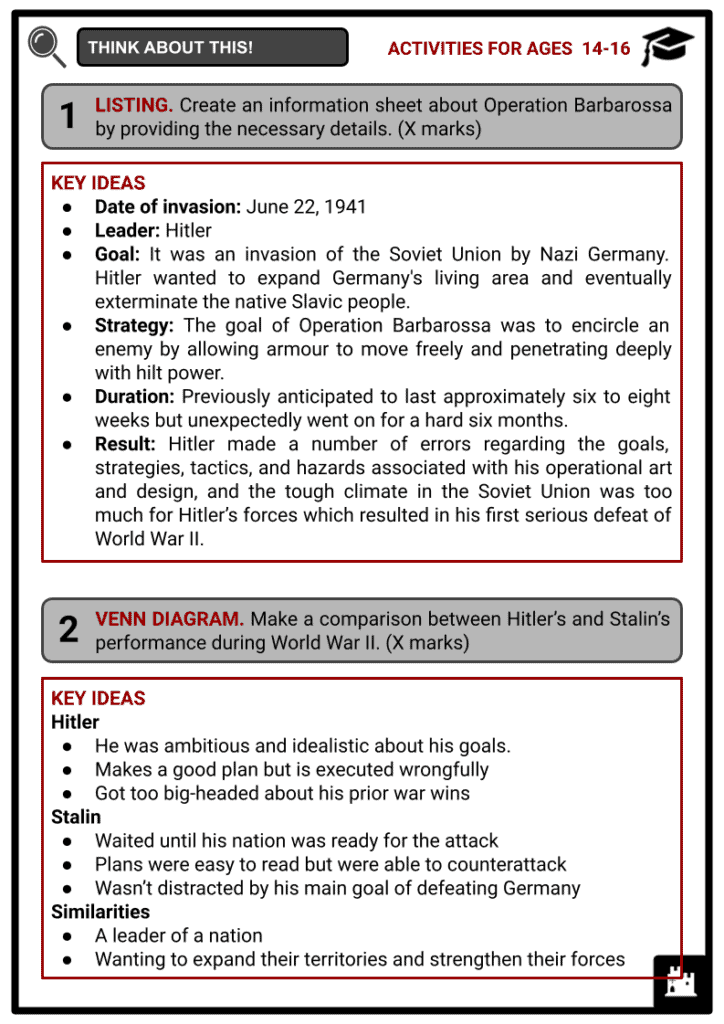Operation Barbarossa Worksheets
Do you want to save dozens of hours in time? Get your evenings and weekends back? Be able to teach about Operation Barbarossa to your students?
Our worksheet bundle includes a fact file and printable worksheets and student activities. Perfect for both the classroom and homeschooling!
Summary
- History and Background
- Goals and Objectives
- Military Capabilities and Conclusion
Key Facts And Information
Let’s find out more about Operation Barbarossa!
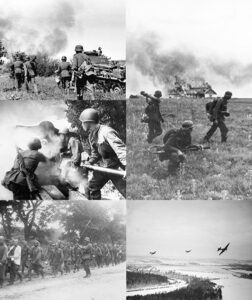
Operation Barbarossa was a World War II invasion of the Soviet Union by Nazi Germany and many of its Axis allies that began on Sunday, 22 June 1941. Their ultimate goal was to expand Germany's Lebensraum (living area) and to eventually exterminate the native Slavic peoples through mass deportation to Siberia, Germanisation, enslavement, and genocide. The Nazi-Soviet nonaggression pact was violated when German troops invaded Czechoslovakia in 1939.
HISTORY AND BACKGROUND
- Hitler wanted to wage war on two fronts, given his lofty ambitions for the Soviet Union before the start of WWII. Stalin, the leader of Russia, was aware that war would eventually break out, but he needed to wait until his nation was prepared. As a result, in 1939, the Nazi-Soviet Pact was struck by the two countries. The deal was advantageous to both parties. Hitler and Stalin used it as a front for their true goals, which included conquering neighbouring countries' land and strengthening their forces.
- Despite the benefits of the alliance, it was short-lived and came to an abrupt end.
- Hitler was aware that he would eventually invade the Soviet Union since the massive resources and territory there were necessary to carry out the plans he outlined in his manifesto, Mein Kampf.
- The Red Army was the sole obstacle in his path. The blitzkrieg strategy helped the Nazis win a number of swift victories in Yugoslavia, Greece, Belgium, France, and Holland.
- Hitler understood that despite its superior military might, Germany could not afford a protracted conflict with the Soviet Union because it lacked the manpower or resources to wage war on two fronts.
- Hitler drew on a variety of intelligence sources to help him formulate his military and political strategies.
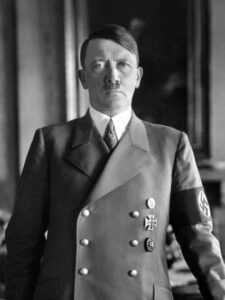
Adolf Hitler According to intelligence reports, the Soviets lacked the resources necessary for a protracted conflict. Their industry and economy were unable to handle it. This information, together with earlier eastern wins, provided Hitler with the assurance to move through with the Soviet Union invasion.
- Operation Barbarossa, which the German army launched on 22 June 1941, was previously anticipated to last approximately six to eight weeks. The operation lasted a difficult six months, despite Germany's early victories. Regarding the goals, strategies, tactics, and hazards associated with his operational art and design, Hitler made several errors. The harsh Soviet climate proved to be too much, much like Napoleon's attempt and gave Hitler his first serious defeat in World War II.
GOALS AND OBJECTIVES
- According to the joint operations doctrine, an end state is "the set of required conditions that defines achievement of the commander’s objectives." Operation Barbarossa had a clear end goal for Hitler as it was being planned. He was aware that if he could beat the Red Army and seize Moscow, the Soviet Union would collapse. Hitler decided, against the advice of his staff, that Leningrad and Kyiv were also essential to his end state, despite the fact that Moscow was the main goal. Choosing to launch an unwise multipronged attack on multiple fronts rather than focusing primarily on Moscow, undermined his use of force. Hitler set the goals and described how to achieve the task regardless of his decision.
- The goal of Operation Barbarossa was to encircle the enemy by allowing armour to move freely and penetrating deeply with airpower and armour. Hitler's comprehension and application of the techniques were crucial to Germany's early-war wins. Hitler eventually miscalculated the roles that planning operations and operational reach played in obtaining his ideal end state, despite the early triumphs.
- German forces were able to employ speed to seize territory, demolish equipment, and swiftly crush the opposition thanks to coordinated blitzkrieg tactics.
- To attain the intended end state with the least cost to workers and other resources, these processes must be planned with precision, coherence, and efficiency.
- Due to weather and logistical challenges, the pace of the blitzkrieg strategy against the Soviets slowed in late July. Hitler made a crucial error during this pause.
- Hitler redirected forces to assist in achieving his other goals at Leningrad and Kyiv rather than taking an operational break and allowing his primary effort to rest and await supplies.
- In order to regenerate combat strength or boost sustainment and forces for the following phase, an operational pause is a short halt in operations. Due to this oversight, the Soviet Union was able to strengthen its defensive positions and transport Stalin's eastern army to Moscow. Hitler's decision to shift units farther from the most advantageous logistical path reduced the operational flexibility of the German armed forces.
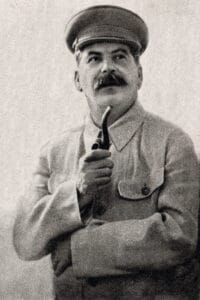
Joseph Stalin - Operational reach is the capacity to use military resources over a specified area and at a specific range. Hitler significantly underestimated the operational range of his soldiers since they outran their logistical support due to the speed and distance at which they advanced.
- Due to poor road conditions and railroads with a different gauge than those in Germany, the Soviet infrastructure further added to Germany's logistical issues. In order to keep up with the quickly advancing army, German forces had to build or rebuild the infrastructure as they went. Hitler's forces stalled mere miles outside Moscow due to poor strategic choices, environmental variables, and deteriorating infrastructure. Hitler was aware of the results of his actions, but he could not manage them effectively.
MILITARY CAPABILITIES AND CONCLUSION
- German infantry troops were able to advance rapidly thanks to the Luftwaffe air force and Panzer tank divisions. The resources used in the ways to carry out the ends are the means. Hitler's primary tool for implementing the blitzkrieg strategy to achieve his goals was the German army. To ensure the effectiveness of strategic and operational initiatives, commanders and planners must understand the centre of gravity (COG). Joint doctrine describes the COG as "the source of power or strength that enables a military force to achieve its objective and is what an opposing force can orient its actions against that will lead to enemy failure”.
- Hitler identified two COGs during the planning stage. The Soviet military served as the operational COG, while Moscow served as the strategic COG. Hitler came to this conclusion because Moscow formed the focal point for the four national instruments of the Soviet Union. Stalin's headquarters in the nation's capital served as the diplomatic centre.
- All commands and information for the Soviet military came from and went via Moscow. Additionally, Moscow supplied 18% of all industries within the Soviet Union. The military and the nation could not run if Moscow fell. Hitler would likely win World War II if he could conquer it and take control of the entire Soviet Union.
- Hitler disregarded the advice of his advisors and the lessons learned from Napoleon's historic unsuccessful invasion, despite the fact that he had properly identified the strategic and operational COGs.
- He strayed from the strategic COG and became sidetracked by unrelated activities in Kyiv and Leningrad.
- In hindsight, he seemed to have conducted a deep penetration move toward Moscow using just one main force. The ideal way to plan activities while remaining within Germany's operational capabilities would have been to coordinate a single effort.
- Other Soviet forces would have been forced to gather in and around Moscow if Soviet forces had been surrounded by Germany's straight path. With this strategy, Hitler would have been able to destroy the Red Army and seize Moscow with just one deadly attack.
- Instead, in an effort to capture Moscow before winter set in, Hitler divided his army into three sections and launched attacks against the entire Red Army across the huge Soviet Union.
- Hitler and his forces were affected by a variety of variables, but his complete contempt for operational art and design caused him to take unwarranted risks.
- Hitler's downfall was the result of a number of assumptions and dangers he risked. Hitler's forces were stranded in Soviet territory through a harsh winter with no clear means of escape and no infrastructure for logistics because they were unable to capture Moscow. Joint planning doctrine says, “military risk is the estimated probability and consequence of the joint force’s projected inability to achieve current or future military objectives while providing and sustaining sufficient military resources."
- Hitler neglected the expense to attain his goal rather than not comprehending risk. Early success for Hitler in the west fuelled his ego and motivated him to take chances in the Barbarossa campaign. He believed he was unbeatable, but the Soviet winter disabused him of that notion.
- Despite having home-field advantage and more soldiers, Hitler did not think the Red Army could stand up to his forces. Due to flawed intelligence, he also undervalued the military and economics of the Soviet Union. He thought the Soviet Union's industrial production capacities couldn't keep up with the pace of his blitzkrieg and or handle a prolonged conflict.
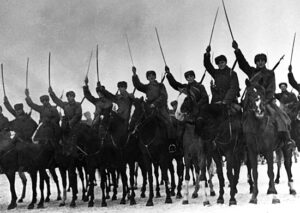
Battle of Moscow - Last but not least, poor operational management spoiled crucial scheduling. Because of the improper resource distribution, the primary German effort was unprepared and vulnerable to a Soviet counterattack. The weather kept getting worse, greatly impeding the already exhausted and freezing blitzkrieg army. There were dangers to the mission and the troops associated with the decision to leave the strategic and operational COGs, and there were no countervailing mitigating measures in place.
- Nazi forces stalled within miles of Moscow as a result of Hitler's reckless choices.
- The culmination, or the moment in time or space when the operation can no longer retain momentum, is what the joint planning doctrine refers to.
- Taking advantage of these errors, the Soviet Union launched a counterattack.
- The Soviet Union switched from defence to offence on 6 December 1941, which was the turning point for the invasion and the outbreak of World War II.
- The next day, Japan bombed Pearl Harbour, launching the U.S. into World War II. Now, Hitler was up against Russia to the east and the United Kingdom, United States, and other allies to the west.

